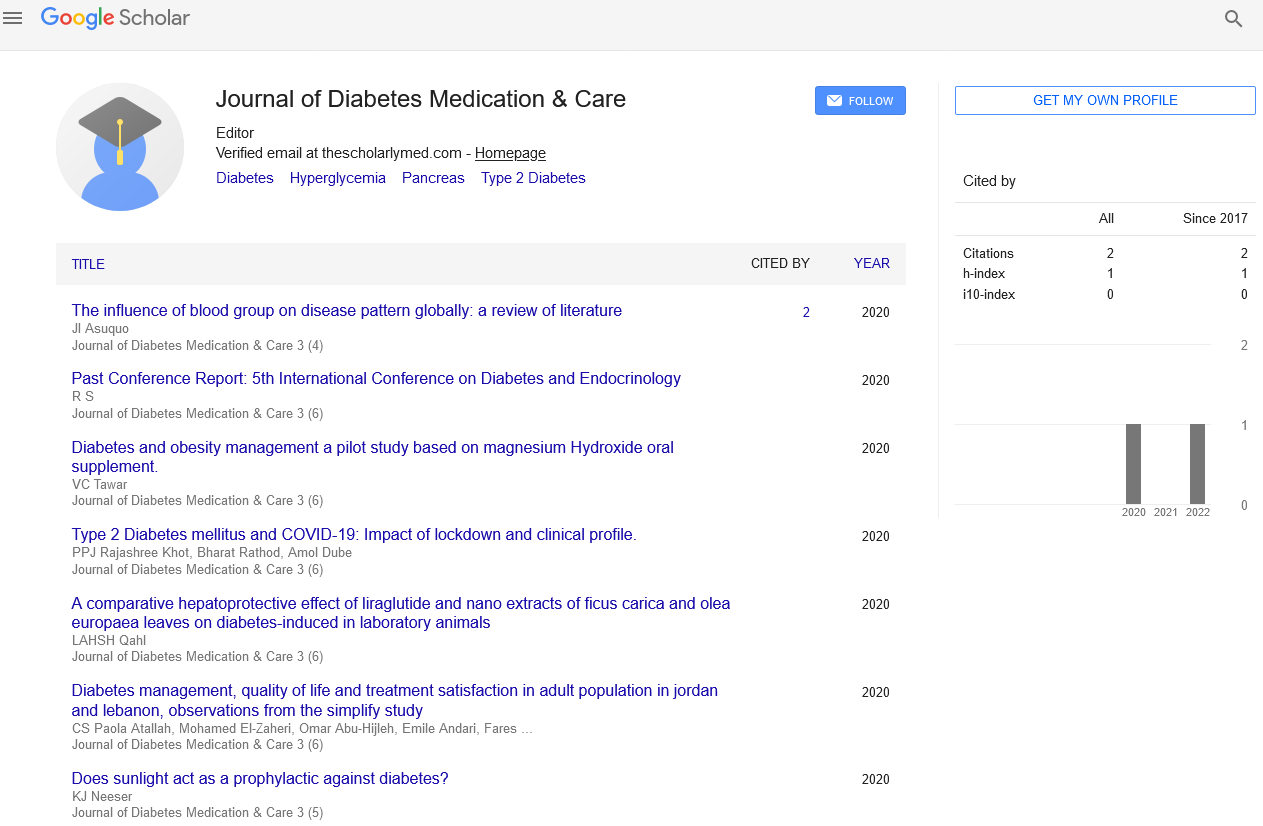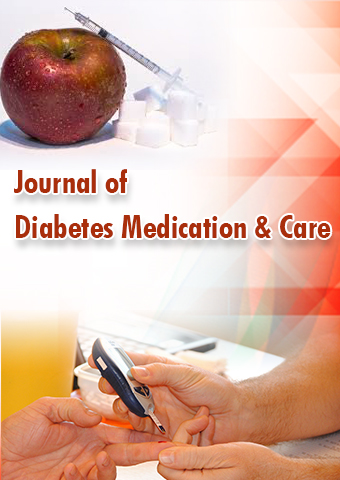Perspective - Journal of Diabetes Medication & Care (2024) Volume 7, Issue 5
Combination Therapies in Diabetes Management: A Comprehensive Approach
- Corresponding Author:
- Yorunm Loazyun
Department of Diabetes, King Saud University, Riyadh, Saudi Arabia
E-mail: laozyumyorum@math.biu.ac.il
Received: 06-Sep-2024, Manuscript No. JDMC-24-148349; Editor assigned: 09-Sep-2024, PreQC No. JDMC-24-148349 (PQ); Reviewed: 23-Sep-2024, QC No. JDMC-24-148349; Revised: 14-Oct-2024, Manuscript No. JDMC-24-148349 (R); Published: 21-Oct-2024, DOI: 10.37532/JDMC.2024.7(5).253-254
Introduction
Diabetes is a complex, chronic condition characterized by elevated blood glucose levels due to the body’s inability to produce or effectively use insulin. As the prevalence of diabetes continues to rise globally, reaching over 537 million adults in 2021, innovative treatment strategies are essential. One such strategy gaining prominence is combination therapy, which involves the use of two or more medications to manage blood sugar levels effectively. This article explores the rationale, benefits, and emerging trends in combination therapies for diabetes management.
Description
Understanding diabetes and its challenges
Diabetes is primarily classified into two types: Type 1 Diabetes (T1D) and Type 2 Diabetes (T2D). T1D is an autoimmune condition where the immune system attacks insulin producing beta cells in the pancreas. T2D, on the other hand, is characterized by insulin resistance, where the body cannot effectively utilize insulin, often accompanied by relative insulin deficiency. Both types present unique challenges in management, as individuals may experience fluctuating blood sugar levels, comorbid conditions, and varying responses to medications.
Managing diabetes typically involves lifestyle changes, such as diet and exercise, alongside pharmacological interventions. However, many patients struggle to achieve optimal glycemic control with single-agent therapies alone. This is where combination therapies come into play.
Rationale for combination therapies
Combination therapies are designed to address the multifactorial nature of diabetes. Each medication targets different mechanisms in glucose metabolism, allowing for a more comprehensive approach to treatment. For instance, while one medication may enhance insulin sensitivity, another might increase insulin secretion or reduce glucose production in the liver. By leveraging the strengths of multiple drugs, healthcare providers can achieve better glycemic control while minimizing side effects and the risk of complications.
Moreover, combination therapies can help overcome issues such as drug tolerance and reduced efficacy over time. For instance, many patients on monotherapy eventually experience a plateau in glycemic control, necessitating the introduction of additional agents.
Commonly used combination therapies
Metformin with other agents: Metformin remains the first-line treatment for T2D due to its well documented efficacy and safety profile. It can be effectively combined with various medications, such as:
Sulfonylureas: These drugs stimulate insulin release from the pancreas. Combining metformin with sulfonylureas can enhance blood sugar control but requires careful monitoring to avoid hypoglycemia.
GLP-1 receptor agonists: Medications like liraglutide and semaglutide can be combined with metformin to improve glycemic control and promote weight loss, which is particularly beneficial for overweight patients.
SGLT2 inhibitors and GLP-1 agonists: Both classes of medications have shown cardiovascular and renal benefits. For example, combining empagliflozin (an SGLT2 inhibitor) with semaglutide can lead to significant reductions in HbA1c levels while also reducing the risk of heart failure and kidney disease.
Insulin and other agents: In patients with T2D requiring insulin therapy, combining basal insulin with other agents can enhance glycemic control. For instance, using long acting insulin alongside GLP-1 agonists can help manage postprandial glucose levels effectively.
Benefits of combination therapies
Enhanced glycemic control: Studies have consistently shown that combination therapies lead to greater reductions in HbA1c levels compared to monotherapy. This is crucial for preventing long term complications associated with diabetes, such as neuropathy, retinopathy, and cardiovascular disease.
Weight management: Many combination therapies, particularly those involving GLP-1 receptor agonists and SGLT2 inhibitors, can aid in weight loss. This is a significant advantage, as obesity is a common comorbidity in T2D and contributes to insulin resistance.
Cardiovascular and renal protection: Emerging evidence highlights the cardiovascular and renal benefits of certain combination therapies. For example, the combination of SGLT2 inhibitors and GLP-1 agonists has shown promise in reducing the risk of cardiovascular events and preserving kidney function in patients with diabetes.
Reduced risk of hypoglycemia: By using medications that work through different mechanisms, combination therapies can help lower blood sugar levels without increasing the risk of hypoglycemia, particularly when avoiding excessive insulin use.
Emerging trends in combination therapies
Fixed dose combinations: Pharmaceutical companies are increasingly developing fixed dose combination therapies that simplify treatment regimens. For example, a single pill containing metformin and an SGLT2 inhibitor can improve adherence and convenience for patients.
Personalized medicine: Advances in genetic and biomarker research are paving the way for more personalized approaches to diabetes management. By tailoring combination therapies to individual patient profiles, healthcare providers can optimize treatment efficacy and minimize adverse effects.
New drug classes: Ongoing research is yielding novel drug classes that can be used in combination with existing therapies. For instance, dual GIP/GLP-1 receptor agonists are being investigated for their potential to enhance glycemic control and weight loss.
Digital health integration: The integration of digital health tools, such as continuous glucose monitors and smartphone applications, is facilitating more dynamic management of diabetes. These technologies can help patients and providers assess the effectiveness of combination therapies in real time and make necessary adjustments.
Challenges and considerations
While combination therapies offer numerous benefits, they also present challenges. Polypharmacy can increase the risk of adverse drug interactions, and managing multiple medications can be complex for patients. Additionally, healthcare providers must consider the cost and accessibility of various medications, as affordability can be a barrier to effective diabetes management.
Patient education and support are essential to ensuring adherence to combination therapies. Empowering patients with knowledge about their condition and treatment options can foster better self-management and improved health outcomes.
Conclusion
Combination therapies represent a promising avenue in the management of diabetes, addressing the multifaceted nature of the disease and enhancing glycemic control. As research continues to evolve, healthcare providers must remain informed about emerging therapies and strategies to tailor treatment to individual patient needs. By embracing a comprehensive approach to diabetes management, we can improve patient outcomes, reduce the burden of complications, and enhance the quality of life for those living with diabetes. The future of diabetes care lies in collaboration between healthcare providers, patients, and innovative therapies to navigate the complexities of this chronic condition effectively.

